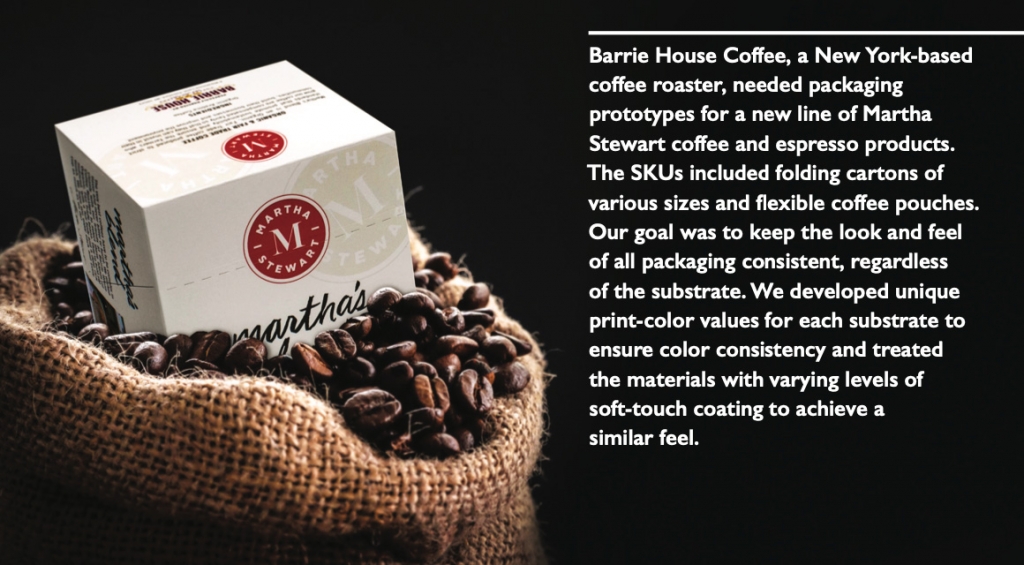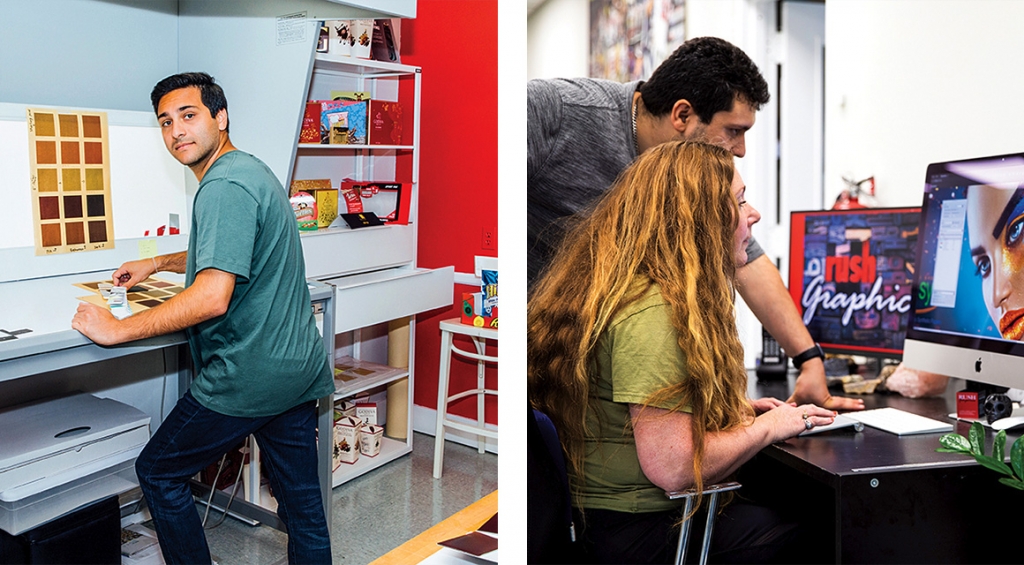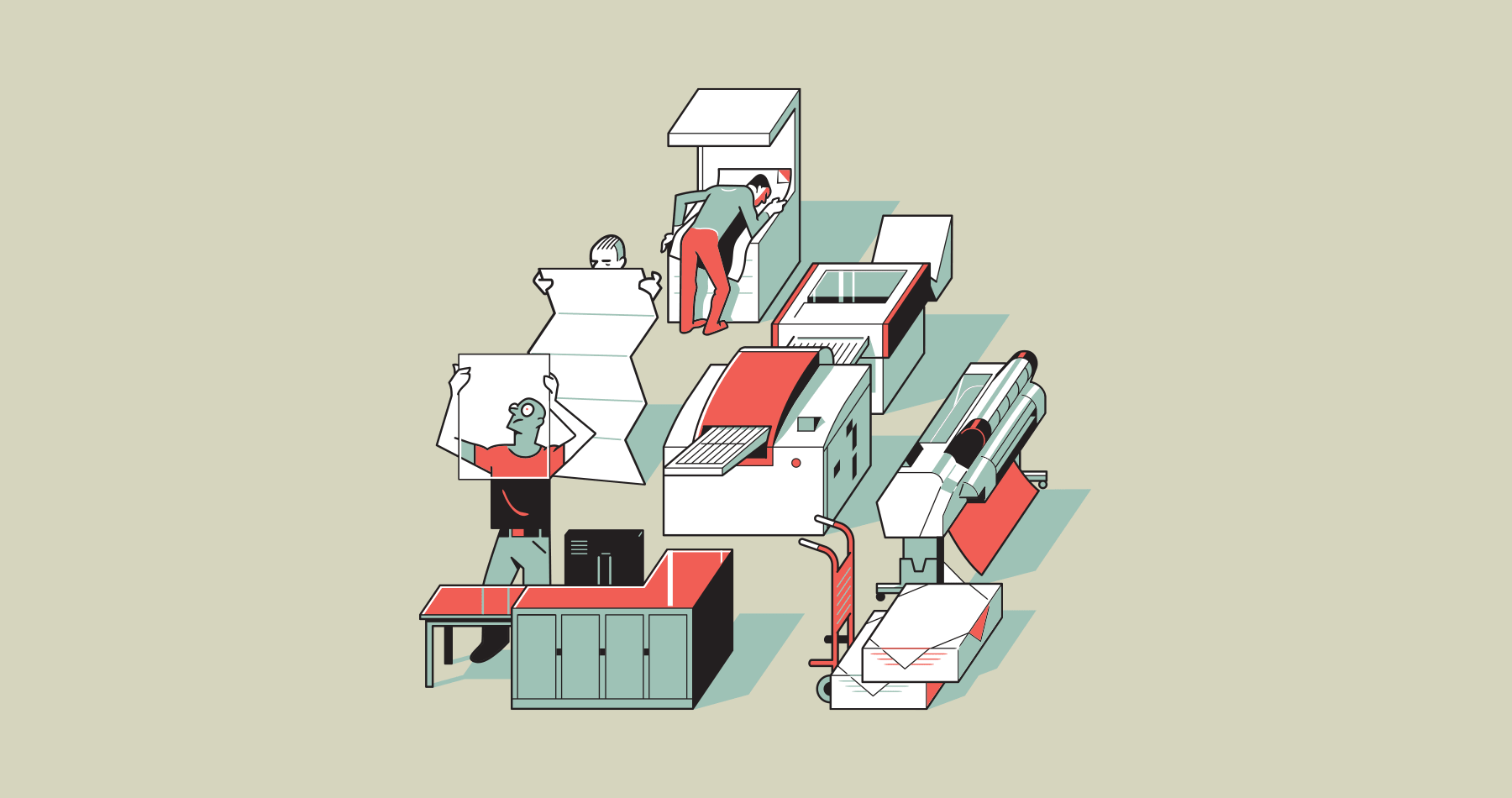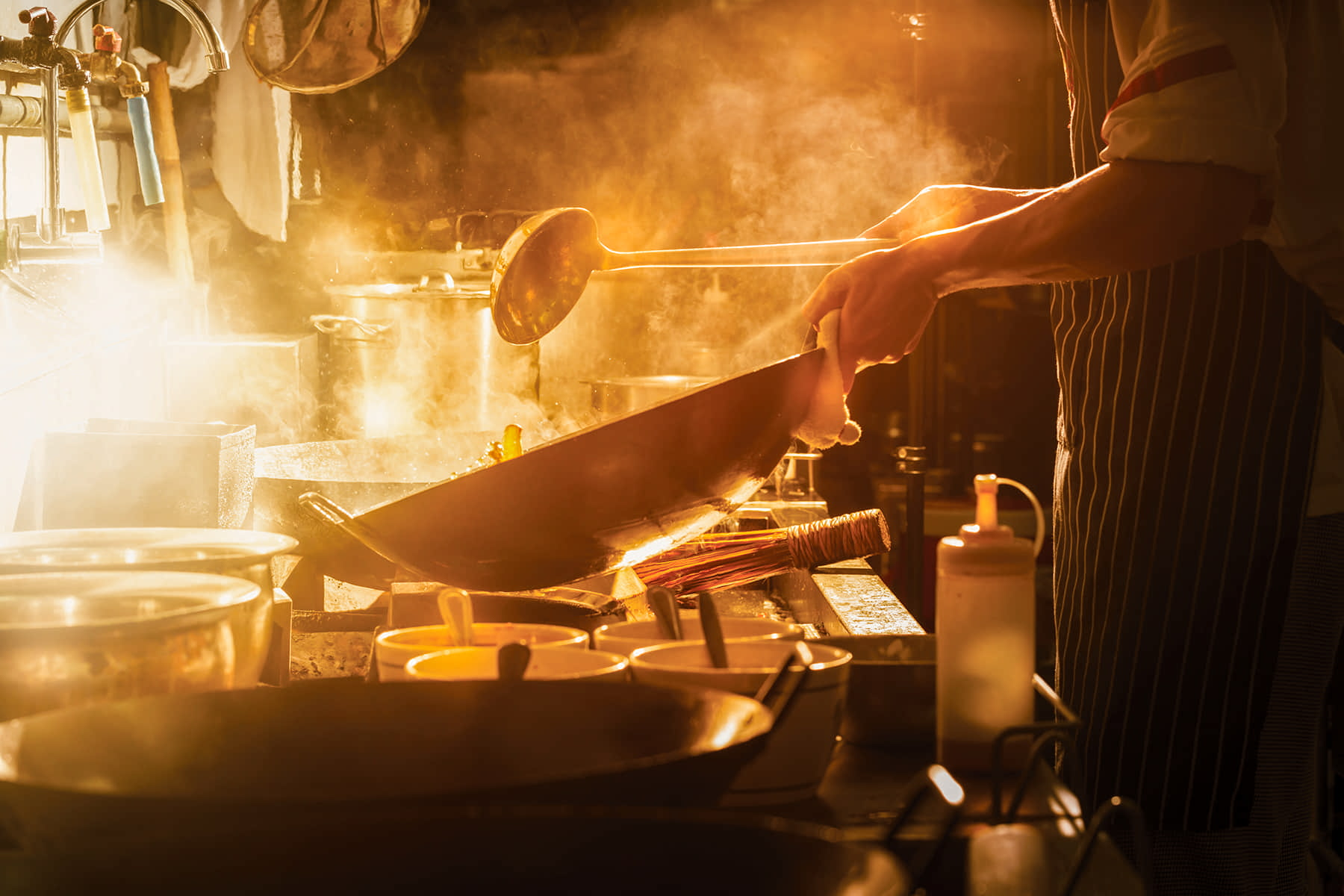Rush Graphic’s evolutionary tale of mixing art and Technology in print.
By Zora Agheli
[stag_dropcap font_size=”100px” style=”squared”]I[/stag_dropcap] have always been fascinated by the limitless possibilities when you really know the capabilities of the technology you are using. That has been a driving force for me — to know what’s coming down the pike for evolving software and hardware and to invest in the tools that will make our products better. Over the last 30 years, just about everything having to do with the print industry has changed, and I’ve made it my business to change with it.
I think of my business, Rush Graphics, not as a print shop, per se, but as an art studio. We’re a high-quality, low-volume studio known for our meticulous work with color. We print everything from advertising materials to packaging, but our niche is creating packaging mockups for which color is critical. We’ve have had some of our customers, like Godiva Chocolatier and the New York Giants, for more than 20 years. Among our other well-known clients are Pantone; The Metropolitan Museum of Art; Becton, Dickinson and Company; Flipz; and Japan Tobacco International — a wide spectrum of companies united in their need for top-notch, accurate reproduction. They trust us to deliver fail-proof prototypes that they can turn around and use for very long, very expensive (read: high risk) print runs.
Roots in the Art Form
I believe our success stems from our expertise. As the founder and leader of the company, I’ve put great emphasis on the importance of being experts at the foundational components that go into advertising and packaging printing — color, photography, design, and layout.
I came to print with that kind of background myself. After earning a bachelor’s degree in photog-raphy and design, and a master’s in communications arts, I worked as a photographer and designer in a full-service shop in New Jersey. We specialized in photography and design, prepress, and printing.
That’s where I learned to appreciate what technology can do to either detract from or improve a visual product. The shop had a Crossfield laser scanner — the first fully digital drum scanner. I remember my boss taking my photographs, laser scanning them, and giving them back to me with a color key that looked nothing like my original. I knew I could do a better job myself. I became an expert on the color scanner so I could have total control over my work and how it would print. I enjoyed playing around with the color to get precisely the hues I wanted. The process fascinated me, and the results were amazing. I was hooked.
In 1984, I opened Rush Graphics in Passaic, N.J. with $20,000 of personal savings. I set up a few dark rooms and purchased a Royal Zenith drum scanner, a horizontal graphic arts camera system, and a few vacuum exposure units. We were the only small company in the New York area that had a digital color scanner. I hired two professional film strippers, who worked with me part time in the evenings, and had a rotation of full-time interns. We had a total of just four clients — a couple of ad agencies, a print shop, and a publishing company. But we made a name for ourselves as a high-end prepress and color separation shop. Within three years, we grew to more than 100 accounts, 10 full-time employees, and $500,000 in annual sales.
And here’s what I noticed: Our competitors, many of whom were much bigger prepress shops, were run by people who were technicians more so than artists. My art background allowed me and my team to use the same tools but differently. I viewed a scanner as if it were a camera, for example. By using different filters, I could color correct and change colors while scanning, so there was often no need for reshooting, which was a common step in larger shops.
Our expertise enabled us to insert ourselves into the creative process. We could not only achieve a client’s desired look but also bring suggestions to the table. Printing is a high-touch field, and I called on my technical expertise and art knowledge to perfect the work. If a designer wanted to print a rose-colored package in four colors and stamp it so a spot would pop, we could recommend that they instead use two Pantone colors, which reduced the printing cost by half. Then we might suggest printing the piece on a foil, for instance, which would have the same effect as a stamp. In the end, they would get their job for a fraction of the cost, and it would look better when produced on a large scale. We saved so much time and money for our clients that new ones began to seek us out.
Investing in the New
From the beginning of my career, I have always been on the lookout for any new technologies that will yield a better product.
As soon as my equipment had a new digital version available, I would invest in it. I bought my first fully digital Dainippon drum scanner in 1987, when I was 31. At about the same time, I bought my first Apple Macintosh to support the traditional camera and darkroom, although it really wasn’t the standard technology until the early 1990s.
I have always pushed my staff to learn about technology along with me. I mentioned the film strippers I hired when I first opened my shop (one of whom is still with me). In 1990, when pretty much all prepress work was becoming digital, I bought two Macs for the lead stripper and his team of five. I told them to go ahead and continue doing the stripping on the table, but that they also had to do it on the Mac. They never went back to the table.
The Mac gave us a tool to do our work much easier, quicker, and more accurately. It used to be, for example, that if a client wanted to change the color of a headline, it would take three hours. You would choose a new color, strip it into clear film with different angles and screen values, compose it to negatives, and finally make a proof from negative. Only then you would see the exact color; at that point, if you made a little mistake or the color didn’t look right, you had to go back to the table. I stayed late so many nights to make simple changes. I hated the tedious, unforgiving nature of that manual process. With the computer, you could just click the color bar and change the color. Simple. And simply miraculous.
In 1992, I installed Adobe Photoshop and Illustrator on-site so we could have more control over the photos we were taking for our clients. We had a lot of ad agency clients back then, and the prepress work was time-sensitive and time-consuming. Clients had print deadlines, which meant we had delivery deadlines. We needed the efficiency Photoshop provided. Technology, once we learn it, has always saved us time and money.
By the end of 1990s, I had 15 people working for me (as I do today) and sales of over $2 million per year. I had a full design room and photo studio. Half of my prepress work was done in the traditional way, but everything else was digital — with Adobe Illustrator, Photoshop, and QuarkXPress.
Between 2008 and 2014, I reinvested in the company and in more digital equipment. Our first digital press was an HP Indigo S2000. We upgraded from that to two HP Indigo 5500s. We were one of the first printers in the U.S. to run white ink digitally, and we did it on this press. We were also one of the only shops to utilize light cyan and light magenta at all times on this press for a wider color gamut. In 2014, we upgraded to the Indigo 7800, which we have now (with 7900 software). We were the first printer on the East Coast to install this press. We also purchased a digital die-cutter and HP flatbed printer during this time. These investments enabled us to go completely digital (except in finishing), and the return was dramatic; the equipment started to pay for itself after the second month in operation. Each time we invested in equipment, we increased our capabilities and took on more work. As a result, our costs went down and our quality improved. We passed the savings on to our clients and have continued to keep our prices competitive. Today, our annual sales have reached $4 million.

Clockwise: Zora’s son, Manee, project and account manager; a Rush creative team completing a retouching project; package production for Anthropologie’s Snow Bunny Balms lip gloss (utilizing a CMYK background color to exhibit a kraft paper look on a white substrate); and a packaging comp for a DeMet’s Candy Company brand.
Partnering with Clients
Our clients range from packaging designers and design teams to marketing executives. We try to operate as an extension of their teams, helping to bring their ideas to fruition. A brand designer often creates the concepts for packaging, and we rework files to make their vision attainable in high-run production. When creating packaging mock-ups and prototypes, we produce different color swatches to ensure accurate results. Our presses are calibrated to the same degree as those used in high-volume production, so we’re able to save our clients stress. When they see products created by us, they know exactly what the final product will look like before they invest tens of thousands of dollars in printing. We prep and finalize files and then work with production printers to make sure there are no surprises.
Because some of our clients print overseas, we developed a system about 15 years ago that accounts for the different CMYK standards often used in Europe and Canada. It’s a tiny color difference, but if you use U.S. standard process ink for separation, the end product will look different when printed with their ink, so I’ll use European ink colors in our digital HP press for proofs. These are the kinds of steps we take to ensure that our attention to detail and color will translate to the final end product.
Always Looking Ahead
I am always looking for new equipment and keeping my eyes peeled for new technology. That’s how I’ve continued to grow this company, which has doubled in sales over the past 20 years. It’s very important in this industry because packaging trends change every few years. If you can’t do what’s next on the horizon, you’re never going to stay in business. We stay relevant and market ourselves for the time we are in. Right now, we’re on the lookout for digital finishing equipment. While the technology is not quite “there” yet, we have been keeping a close eye on its evolution. For instance, we just invested in a Trotec laser cutter that can laser engrave on pint glasses and plaques. It also offers intricate cutting on acrylic, glass, wood, and paper — all with a short turnaround time because it’s digital. To me, it was a low-risk investment because it’s not very expensive and is easy to learn. We recently used it to cut the New York Giants logo into an acrylic sign.
We’ve had a Zund digital-die cutter for about 10 years. Together with the Trotec, which can cut smaller, more intricate patterns, we can offer our clients another layer of packaging production. When you have these types of machines, you can offer a variety of solutions and ideas. We’re here not only to be told what the customer wants, but also to proactively offer suggestions. Designers can test out their ideas or ours, and many times, our suggestion ends up in production.
Like everyone else, we do a lot of research before we invest in new equipment. We go to print shows, participate in demos, read articles, and watch videos so that when we see a new technology that will be useful to our customers, we can act quickly. For instance, one of my employees went to a print show in Chicago last spring and saw an Epson SureColor roll printer and excitedly reported back to us from the show floor. We set up a demo for later that very day. By the time he got back to the shop, we had ordered it. Now we have a printer that can print on all kinds of materials, with better color quality results than a flatbed printer.
Our next big investment will likely be a 3D printer to prototype packaging. With it, we could make a prototype of a piece of jewelry, for instance, photograph it, and use it in an ad. We’ve been doing a lot of research over the last few years and are waiting for the technology to get to where we want it to be. I want to be the first one to have this kind of printer in my shop, once the quality and price are right. Imagine how much we could play?
So today, after being in business now for almost 35 years, I still find myself waiting for the technology to catch up with me.
Zora Agheli is the owner and CEO at Rush Graphics in Hawthorne, New Jersey. She came into the business as a photographer and videographer and started her own company offering prepress and color separation work. Rush Graphics specializes in creating comps for packaging, and its clients include brands such as Godiva Chocolatier and the New York Giants. Connect via agheli@leadingprint.org.
Other recent articles

The Vanishing

Weighing In

We’re OK

The Guide

By The Numbers

